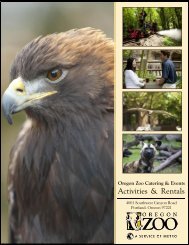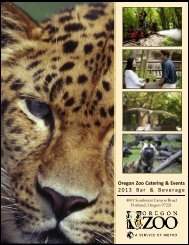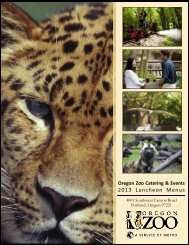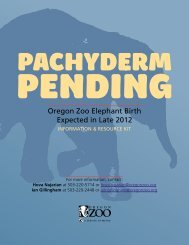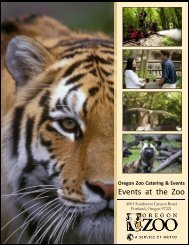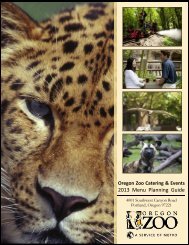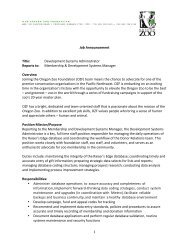Create successful ePaper yourself
Turn your PDF publications into a flip-book with our unique Google optimized e-Paper software.
Conservation in north america<br />
Species Survival Plan<br />
and Taxon Advisory Group<br />
The <strong>Elephant</strong> Species Survival Plan (SSP) was established<br />
in 1985 as a cooperative program to manage the elephant<br />
population in North American zoos. Administered<br />
by the Association of <strong>Zoo</strong>s and Aquariums, the elephant<br />
SSP’s goal is to maintain a healthy, sustainable elephant<br />
population that is both genetically and demographically<br />
stable by managing breeding protocols among member<br />
zoos.<br />
The <strong>Oregon</strong> <strong>Zoo</strong>’s director of elephant habitats, Mike<br />
Keele, was an SSP founding member and served as<br />
the species coordinator for the elephant SSP through<br />
2000when it was reorganized to become a Species<br />
Survival Plan and Taxon Advisory Group (TAG/SSP). He<br />
served as chair of that group until 2010. The <strong>Elephant</strong><br />
TAG/SSP manages the North American elephant population<br />
by recommending breeding and transfers. Additionally,<br />
the <strong>Elephant</strong> TAG/SSP oversees population<br />
management, reviews research and education proposals,<br />
sets conservation priorities, and develops husbandry<br />
manuals, which set standards based on current scientific<br />
knowledge in the areas of diet, housing, enrichment and<br />
care of elephants in zoos.<br />
In addition to the SSP coordinator, two “studbook keepers”<br />
maintain the vital records of the entire North American<br />
population of both species (African and Asian),<br />
including births, deaths, transfers and lineages. Keele<br />
authored the original studbook for Asian elephants and<br />
continues to maintain it with new information.<br />
Using the studbook, the management group creates a<br />
master plan that outlines the goals for the entire North<br />
American populations of both African and Asian elephants.<br />
It designs a “family tree” for each elephant in<br />
order to plan breeding for maximum genetic diversity. In<br />
addition to the recommendations about which elephants<br />
are most important to breed, master plans include recommendations<br />
to avoid breeding elephants that already<br />
have many offspring and siblings in the populations.<br />
To learn more, visit elephanttag.org.<br />
Breeding at the <strong>Oregon</strong> <strong>Zoo</strong><br />
The <strong>Oregon</strong> <strong>Zoo</strong> has one of the most successful breeding<br />
programs for captive elephants in the world. Twentyseven<br />
Asian elephants have been born here over the<br />
past five decades, which amounts to 17 percent of all<br />
elephants born in North America during that period.<br />
When Packy was born at the <strong>Oregon</strong> <strong>Zoo</strong> in 1962, he<br />
was the first elephant to be born in the Western Hemisphere<br />
in 44 years. The <strong>Oregon</strong> <strong>Zoo</strong> was the first zoo<br />
to achieve second-generation breeding by producing<br />
elephant calves from elephants born in Portland.<br />
The zoo has pioneered Asian elephant breeding, with<br />
important discoveries such as the length of the elephant<br />
gestation period and how to monitor the estrous cycle<br />
of female elephants to know when they are capable of<br />
breeding.<br />
The <strong>Oregon</strong> <strong>Zoo</strong>’s elephant facility is one of the major<br />
reasons its breeding program has been so successful.<br />
The zoo can house adult bull elephants, allowing for<br />
normal behavior during musth, when they can be extremely<br />
aggressive. At the same time, the facility is also<br />
large enough to house normal social groups of female<br />
elephants, creating a healthy breeding population.<br />
The zoo is currently monitoring Rose-Tu, due to give<br />
birth in late November or December 2012. Rose-Tu was<br />
impregnated by Tusko, who arrived at the <strong>Oregon</strong> <strong>Zoo</strong><br />
in 2005 on breeding loan from a California elephant<br />
facility. The zoo acquired Tusko to restart its breeding<br />
program because its other two bulls, Rama and Packy,<br />
are overrepresented in the gene pool and related to<br />
Rose-Tu, making them poor candidates for breeding.<br />
Samudra, born on Aug. 23, 2008, was the last elephant<br />
born at the <strong>Oregon</strong> <strong>Zoo</strong>.<br />
O R E G O N Z O O P A C h y d e r m P r e s e n t 2 0 1 2 M E D I A K I T<br />
17





